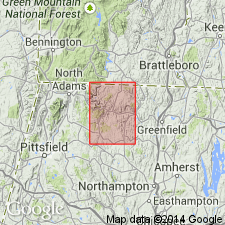
- Usage in publication:
-
- Becket gneiss
- Modifications:
-
- Original reference
- Dominant lithology:
-
- Gneiss
- AAPG geologic province:
-
- New England province
Summary:
Becket gneiss. A light-gray biotite gneiss, underlies Cheshire quartzite.
Source: US geologic names lexicon (USGS Bull. 896, p. 141).

- Usage in publication:
-
- Becket gneiss (also Becket white conglomerate gneiss)
- Modifications:
-
- Original reference
- AAPG geologic province:
-
- New England province
Summary:
Also USGS Monograph 29, p. 18, 31-38, pl. 34. Becket gneiss (also Becket white conglomerate gneiss). Light-gray biotite gneiss, at times a conglomerate. Thickness 2,000(?) feet. Unconformably underlies Hoosac schist and unconformably overlies Washington gneiss. [Shown on p. 18 as underlying Cheshire quartzite.]
Source: US geologic names lexicon (USGS Bull. 896, p. 141).
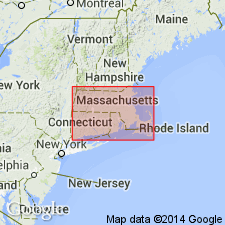
- Usage in publication:
-
- Becket granite gneiss
- Modifications:
-
- Principal reference
- AAPG geologic province:
-
- New England province
Summary:
Pg. 150-155. Called the formation Becket granite gneiss. "Named for fact it is quarried at Becket, Massachusetts."
Source: US geologic names lexicon (USGS Bull. 896, p. 141).
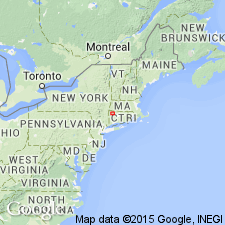
- Usage in publication:
-
- Becket quartz monzonite gneiss (intrusive)
- Modifications:
-
- Revised
- AAPG geologic province:
-
- New England province
Summary:
Pg. 197+. Becket quartz monzonite gneiss (intrusive). B.K. Emerson chose the even-grained slightly gneissic rock of the quarry of Ball Mountain, north of Norfolk, Connecticut, as one of type localities of Becket gneiss. Present study confirms existence of this rock as a separate type and Emerson's name is retained for it where present in Connecticut. But Becket as mapped in preliminary geologic map of Connecticut included much more. The Becket of Emerson intrudes Sharon Mountain quartz diorite, Barrack Mountain granite gneiss, and Grenville. [In 1934 (Amer. Jour. Sci., 5th ser., v. 27, p. 356) Agar adopted Becket granite gneiss as appropriate name of the formation.]
Source: US geologic names lexicon (USGS Bull. 896, p. 141).
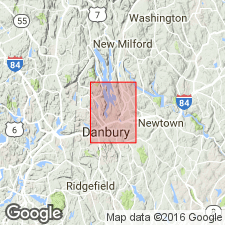
- Usage in publication:
-
- Becket gneissic granite and trondhjemite
- Modifications:
-
- Revised
- AAPG geologic province:
-
- New England province
Summary:
Pg. 4. Informally called gneissic granite and trondhjemite in report on Danbury quadrangle.
Source: US geologic names lexicon (USGS Bull. 1200, p. 263).
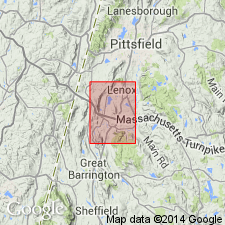
- Usage in publication:
-
- Becket Granite Gneiss†
- Modifications:
-
- Abandoned
- AAPG geologic province:
-
- New England province
Summary:
†Becket Granite Gneiss abandoned; its rocks now included in Tyringham Gneiss (reinstated as meta-intrusive orthogneiss) and unnamed paragneiss unit.
Source: Changes in stratigraphic nomenclature, 1975 (USGS Bull. 1422-A, p. A2-A3).
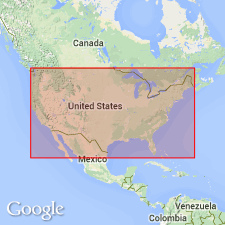
- Usage in publication:
-
- Becket Granite Gneiss
- Modifications:
-
- Not used
- AAPG geologic province:
-
- New England province
Summary:
Talc deposit enclosed in Middle Proterozoic biotite gneiss in Berkshire massif; biotite gneiss were referred to as Hinsdale Biotite Gneiss or Becket Granite Gneiss by Chute (1969, USGS Open-File Report 1217).
Source: GNU records (USGS DDS-6; Reston GNULEX).
For more information, please contact Nancy Stamm, Geologic Names Committee Secretary.
Asterisk (*) indicates published by U.S. Geological Survey authors.
"No current usage" (†) implies that a name has been abandoned or has fallen into disuse. Former usage and, if known, replacement name given in parentheses ( ).
Slash (/) indicates name conflicts with nomenclatural guidelines (CSN, 1933; ACSN, 1961, 1970; NACSN, 1983, 2005, 2021). May be explained within brackets ([ ]).

